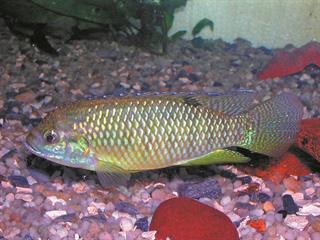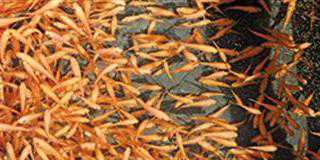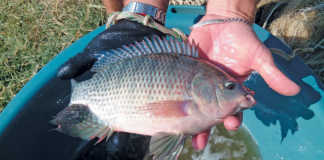
‘Tilapia’ is a general term for the cichlids of several genera from the family Cichlidae, commonly known as ‘bream’ or ‘kurper’. There are many species, found in a wide variety of habitats across Africa. Oreochromis is the mouth-brooding genus, while Tilapia are the substrate spawners.
Many people are familiar with the Mozambique tilapia (Oreochromis mossambicus), also known as the blue kurper or ‘mossie’.
This is the common and widespread tilapia found in the Lowveld, occurring naturally from Limpopo, down the eastern side of the country to the Eastern Cape. It has a close relative, the black tilapia (O. placidus), which is often mistaken for the blue kurper.
The black tilapia is found only in the north-eastern coastal regions of KwaZulu-Natal, Mkuze, Mgobezeleni Lake, and north into Mozambique as far as southern Tanzania. It has a sooty throat at breeding time – unlike the white cheeks of the breeding male blue kurper – and four spines, not three, in the anal fin.
Tilapia rendalli, the red breast tilapia found in the Mpumalanga Lowveld, northern KZN and Limpopo, grows to about 2kg in mass. It occurs widely throughout tropical Africa, and is replaced by T. zillii north of the equator. In Southern Africa, it is often sympatric with O. mossambicus, but is a more herbivorous, slower-growing species.
The dwarf species, T. sparrmannii or vlei kurper, is more widespread and cold-tolerant. Whereas other tilapia succumb to cold at temperatures below 10°C, the vlei kurper can tolerate 6°C to 8°C for short periods. They rarely exceed 200g and are therefore unsuitable for aquaculture.
Great potential
O. andersonii, the three-spotted bream, is native to the Okavango, Cunene, upper- Zambezi and Kafue river systems. Its features make it ideal for aquaculture research: it can exceed 3kg in weight, grows fast, has a deep body and can tolerate relatively cold water.
At present its growth rate does not outperform that of the improved strains of Nile tilapia (O. niloticus); but if subjected to the same selection process, O. andersonii would have great potential. In the 1990s, Nile tilapia were selected to develop genetically improved farmed tilapia (GIFT), a hugely successful programme, particularly in Asia.
Often overlapping in habitat with O. andersonii is the greenhead bream, O. macrochir. This fine, deep-bodied fish, with its round forehead profile and green head and flanks, grows to over 2,5kg. There are two sub-species with minor differences. This species should also be investigated for aquaculture potential.
Fascinating variety
Many other species of tilapia of both genera are found further north in Africa. They include T. snyderae and T. bakossiorum, both scarlet-coloured dwarf species about 100mm in length from the crater lakes in Cameroon. Closer to home are T. ruweti, a relative of T. sparrmannii, found in parts of the upper Zambezi and Okavango.
This dwarf aquarium species becomes coal black during breeding. T. guinasana, another dwarf species, endemic to the Lake Guinas sink-hole in Namibia, has no fewer than six colour forms.
Tilapia species abound. It is likely, however, that relatively few species will be exploited for aquaculture, even with genetic improvement.













